Histogram visualization
- Latest Dynatrace
- How-to guide
- 3-min read
Use a histogram to visualize the distribution of numerical values.
Examples
Example 1
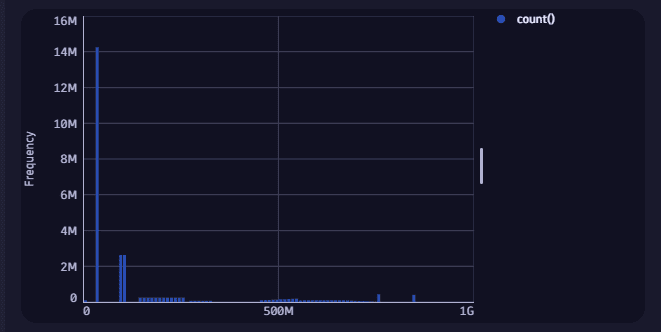
The histogram visualization above is based on the following query.
fetch spans| filter span.kind == "server"| filter duration < 1s| summarize count(), by:{range(duration, 10ms)}
Example 2

The histogram visualization above is based on the following query of bizevents.
fetch bizevents| filter event.type == "com.easytrade.trade-closed"| filter direction == "longsell"| filter amount <= 10000| summarize count = count(), by:{range(amount, 300)}
Example 3
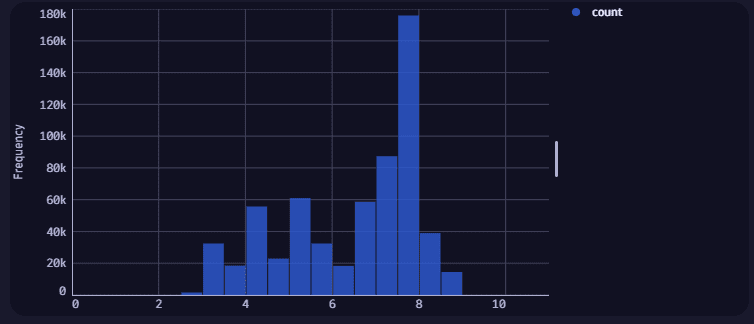
The histogram visualization above is based on the following query. This shows the distribution of risk scores for open security events.
The query below has been updated to align with the new Grail security events table. For the complete list of updates and actions needed to accomplish the migration, follow the steps in the Grail security table migration guide.
fetch security.events| filter event.status == "OPEN"| summarize count = count(), by:{range(vulnerability.risk.score, 0.5)}
Example 4

The histogram visualization above is based on the following query. This is a variation on the previous example that shows an additional split by the security event status.
The query below has been updated to align with the new Grail security events table. For the complete list of updates and actions needed to accomplish the migration, follow the steps in the Grail security table migration guide.
fetch security.events| summarize count = count(), by:{range(vulnerability.risk.score, 0.5), event.status}
Chart interactions
Selection interactions
When you select a value on a chart and pin the displayed tooltip open, you can then hover over the tooltip to display a menu of selection-specific options.
The chart interactions available to you depend on your query and visualization. For example, if you select a host on a line chart and hover over the tooltip, you will see a menu of items such as:
-
Copy name—copy the name of the selected host.
-
Fields—a section with a submenu for each query field. A field submenu offers field-specific options such as:
- Copy value—copy the value of the field. Also displays the field type.
- Hide—hide the field in the chart.
- Explain value—use AI to explain the field.
- Add command to query—a section of field-specific commands that you can automatically add to your query.
- A recommended app may also be listed.
-
Visual options—opens the edit panel so you can change visualization options for the selected item.
-
Set color—opens the edit panel so you can change the color of the selected item.
-
 Go to host—opens the selection in
Go to host—opens the selection in  Infrastructure & Operations.
Infrastructure & Operations.In general, if there are recommended apps to open the selected item, the menu offers direct links to those apps, followed by an Open with option to select a different target app.
-
Open with—for details, see Open with.
Title
Use the title field at the top of the options panel (initially Untitled tile or Untitled section) to add a title to your dashboard tile or notebook section.
- You can use emojis such as 😃 and 🌍 and ❤️.
- You can use variables.
Example:
- Define variables called
StatusandEmojiin your dashboard. - Set the title to
Current $Emoji status is $Status. - Set
StatustoGood. - Set
Emojito🌍.
The title will be displayed as Current 🌍 status is Good.
Visualization
If you aren't sure that you chose the right visualization, use the visualization selector to try different visualizations.
Data mapping
The data mapping section shows how a column of your result is mapped to the visualization.
Expand for general rules on data mapping settings
Expand the Data mapping section of your visualization settings to see how data in your result is mapped to your visualization, and to adjust those settings if needed.
-
Mandatory fields are marked with an asterisk (
*). Example: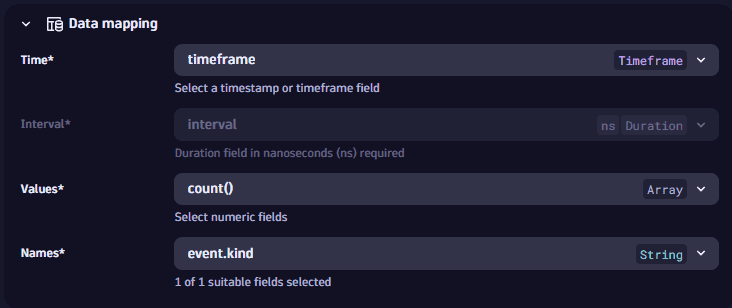
-
Data types are displayed next to field names in dropdowns and mapped fields.
-
Units are displayed when there’s only one assigned.
-
Result fields are grouped into Suitable and Unsuitable. Fields are marked as unsuitable if they cannot be used to display data in the visualization. Example:
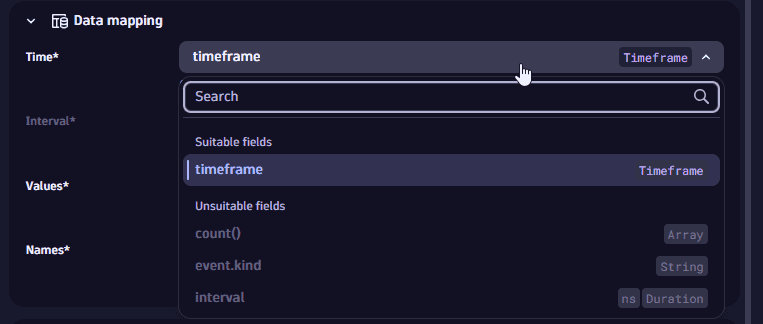
-
Automatic application of data mapping default settings:
Dynatrace version 1.319+
- Already existing tiles and sections are considered to be user-defined. Their data mapping configurations aren't updated automatically.
- Newly created tiles and sections apply a data mapping setting by default. If you don't modify these settings manually, these settings might change if a new execution of the tile/section modifies the results and there are fields missing or new fields that better suit the data mapping.
Visualization-specific data mapping settings
The histogram is defined by an array of bins where each bin represents a continuous range of values. The data mapping section includes:
-
Range: the width (size) of individual bars
-
Values: the count or frequency (value) that determines the height of individual bars
-
Names: the elements displayed, for example, in the legend and series names.
Histogram chart options
To learn about options quickly and decide what works best for you, turn options on and off and see the effect immediately on your chart. For example, does it look best with a label or without? Turn that option on and off and see for yourself.
Color palettes
You can select a color palette from the list under Color palettes.
Legend position
Select where to display the visualization legend:
- Automatic—Dynatrace chooses an appropriate location
- Hidden—no legend is displayed
- Bottom—the legend is displayed along the bottom of the visualization
- Right—the legend is displayed on the right side of the visualization
X-axis
Sets the scale of the X-axis:
- Logarithmic
- Linear
Min
The minimum value of the visualization's x-axis.
- Auto—Dynatrace automatically selects a suitable minimum based on data (0 or min-value).
- Min-value—The minimum is set to the minimum data value.
- Custom—Displays an input field for you to enter a custom minimum value.
Max
The maximum value of the visualization's x-axis.
- Auto—Dynatrace automatically selects a suitable maximum based on data (0 or max-value).
- Max-value—The maximum is set to the maximum data value.
- Custom—Displays an input field for you to enter a custom maximum value.
Label
Text to display as a label for the Y-axis.
Y-axis
Sets the scale of the Y-axis:
- Logarithmic
- Linear
Min
The minimum of the visualization range.
- Auto—Dynatrace automatically selects a suitable minimum based on data (0 or min-value).
- Min-value—The minimum is set to the minimum data value.
- Custom—Displays an edit box for you to enter a custom minimum value.
Max
The maximum of the visualization range.
- Auto—Dynatrace automatically selects a suitable maximum based on data (0 or max-value).
- Max-value—The maximum is set to the maximum data value.
- Custom—Displays an edit box for you to enter a custom maximum value.
Label
Text to display as a label for the Y-axis.
Query limits
Use the Query limits section to check and adjust the Grail query limits per notebook section or dashboard tile. These settings determine the maximum limits when fetching data. Exceeding any limit will generate a warning.
Dashboard tiles and notebook sections created in Dynatrace earlier than version 1.296 are not affected. Those existing tiles/sections will return the same results as before.
-
Read data limit (GB)
The limit in gigabytes for the amount of data that will be scanned during a read.
-
Record limit
The maximum number of result records that this query will return. Default: 1,000 records. To see more records, you need to increase the value of Record limit.
-
If your query has no
limit, such asfetch logsthe value of Record limit is applied. By default, you will see up to 1,000 records.
-
If your query also includes a
limit, such asfetch logs| limit 2000the lower of the two values (either
limitin your query, or Record limit in the web UI) is applied.In the example above, you would still see only 1,000 records unless you increased the value of Record limit.
-
-
Result size limit
The maximum number of result bytes that this query will return. For better performance with typical queries and smaller documents, the default is set to 1 MB.
-
Sampling (Logs and Spans only)
Results in the selection of a subset of Log or Span records.
Thresholds
Configure thresholds
To configure thresholds in a dashboard or notebook visualization
-
Select to edit the visualization tile.
-
Select Thresholds.
- In
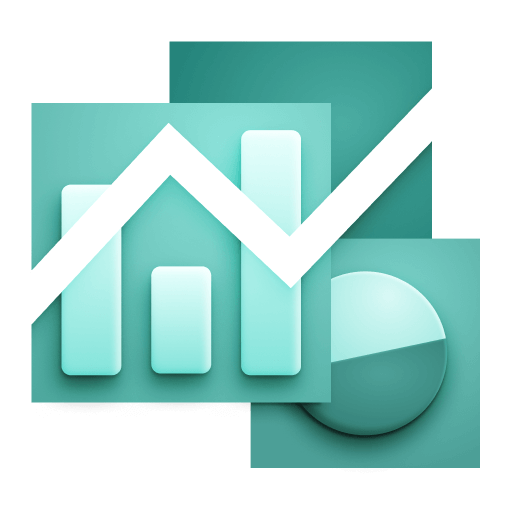 Dashboards, select the Visual tab in the side panel, and then select Thresholds.
Dashboards, select the Visual tab in the side panel, and then select Thresholds. - In
 Notebooks, select Thresholds in the side panel.
Notebooks, select Thresholds in the side panel.
- In
-
Select Threshold.
-
Define the thresholds. For each range:
- Select a color to display for that range
- Select the operator to define the threshold for that range
- Enter a static value to compare (using the selected operator) with the returned value
- Enter a label to associate with the defined range.
- Labels apply only to charts with a Y axis, such as timeseries charts and the categorical bar chart.
- Labels can't be defined for tables and the single value chart.
Example threshold settings in Dashboards
This example uses a bar chart, but the options apply to other visualizations.
-
In
 Dashboards, create a dashboard.
Dashboards, create a dashboard. -
Select and, in the Snippets section of the menu, select Metrics > Chart top 10 hosts by CPU usage.
-
In the section edit panel, select the Visual tab and select Bar.
-
Select Thresholds.
-
Select Threshold.
An empty set of threshold fields is displayed.
-
Define the thresholds for the displayed metric. You can observe your changes in the Y axis of the chart.
In this example, we define three ranges of CPU usage with corresponding colors and labels.
You can see the ranges displayed on the Y-axis and in the tooltip.
To reset to defaults (discard threshold settings), select the trash can next to the item.
Edit thresholds
-
Select to edit the visualization tile.
-
Select Thresholds.
- In
 Dashboards, select the Visual tab in the side panel, and then select Thresholds.
Dashboards, select the Visual tab in the side panel, and then select Thresholds. - In
 Notebooks, select Thresholds in the side panel.
Notebooks, select Thresholds in the side panel.
- In
-
From this point, you can do the following (expand rows for details):
Add thresholds
To add thresholds (if the selected visualization supports additional thresholds), select Threshold.
Turn off thresholds
To turn off (hide) existing thresholds, use the switch. No settings are lost. You can turn them back on if you change your mind.
Delete thresholds
To delete existing thresholds, select the trash can .
Edit threshold settings
To change existing threshold settings, just edit the fields.
Add a range
To add a range to existing thresholds, select Add range.
Delete a range
To delete a range from existing thresholds, select the delete button in that row.
Units and formats
To override the default units and formats in a dashboard or notebook visualization
-
Select to edit the visualization tile.
-
Select the Visual tab.
-
Select Units and formats.
-
Select Override.
-
Select Override
-
In the dropdown list, select the item for which you want to add a unit override.
This is a numeric column of the underlying DQL result, so it varies according to the query. For example:
- A
fetch eventsquery returns events. The dropdown list here lets you select a numeric field (such astransfer_size) from the results. - A
timeseries avg(dt.host.cpu.usage)query returns a single timeseries foravg(dt.host.cpu.usage). That timeseries is then the only selectable option in the list.
- A
-
Define the override.
- Default unit: The base unit in which the values were captured. It's
Noneif it was not included in the DQL result, or its automatically defined by the unit passed from the DQL result. This field doesn't lead to any conversion. - Displayed unit: Once you define a default unit, you can use Displayed unit for conversion. For example, if the DQL result defined your numeric value in the result as
Bytes, Displayed unit now offers a suitable list of byte conversions such asKilobyteandMegabyte. Unlike the Default unit, the Displayed unit is always a numeric conversion. - Decimals displays the default number of decimals (degree of precision) to display. To see it in action, change the Decimals selection and observe the change in the visualization.
- Suffix displays the suffix to display after the unit. To see it in action, enter a string and observe the change in the visualization. When you don't find the unit you're looking for, you can use Suffix to display the desired unit.
- Default unit: The base unit in which the values were captured. It's
-
Turn on Abbreviate large numbers if you want to display large figures in abbreviated form. For example,
1053becomes1.1K.
To reset to defaults (discard override settings for the selected item), select the trash can next to the item.
Example for dashboards
This example uses a line chart, but the options apply to other visualizations.
-
In
 Dashboards, create a dashboard.
Dashboards, create a dashboard. -
Select and, in the Snippets section of the menu, select Metrics > Chart average CPU across all hosts.
-
In the section edit panel, select the Visual tab and select Line.
-
Select Units and formats.
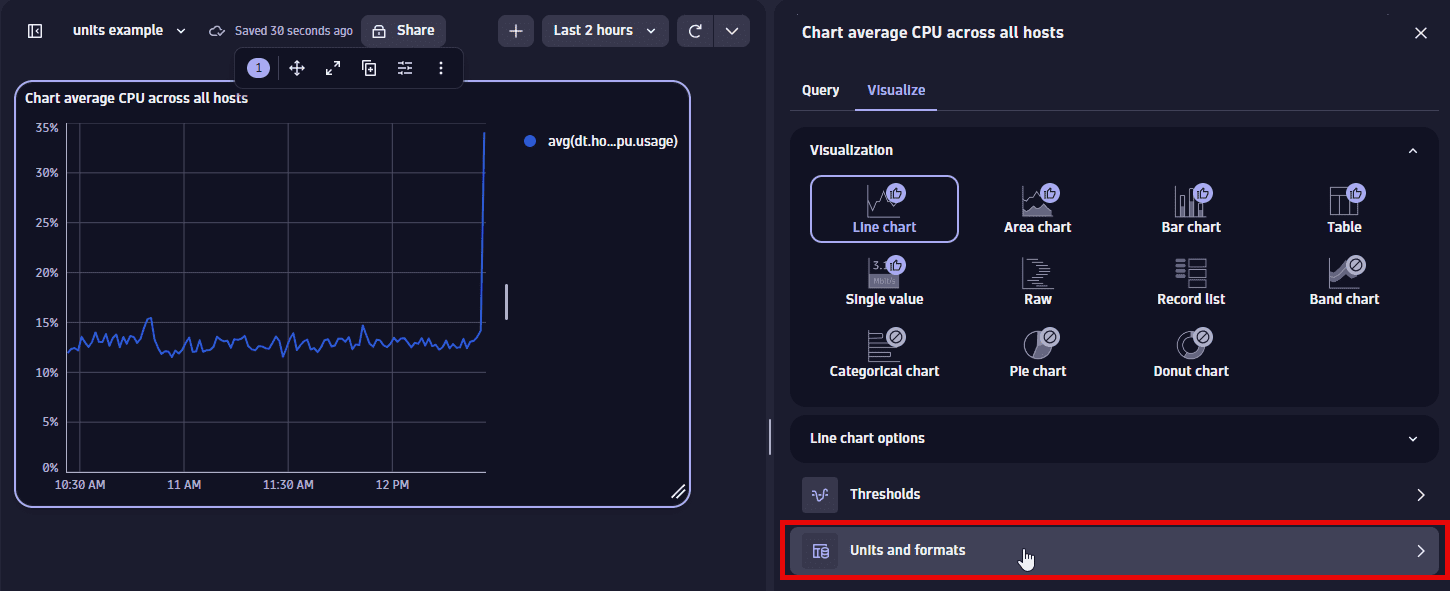
-
Select Override.

-
In the dropdown list, select the metric for which you want to add an override. There's only one metric to select in this example.
-
Define the override for the displayed metric. You can observe your changes in the Y-axis of the chart.
-
Default unit displays
Percent (%), which is the default unit for the selected metric. Try a different setting, such asOneto instead display the result as a fraction of 1. -
Displayed unit displays
Auto. You can change it to a different unit, such asOneto instead display the result as a fraction of 1.Only linear and static conversions are supported. For example, you cannot convert
Degree Celsius(°C)intoDegree Fahrenheit(°F), or convertUsd(US$)intoEur(€). -
Decimals displays the default number of decimal points (degree of precision) to display. To see it in action, change the Decimals selection and observe the change in the visualization.
For example, change this:
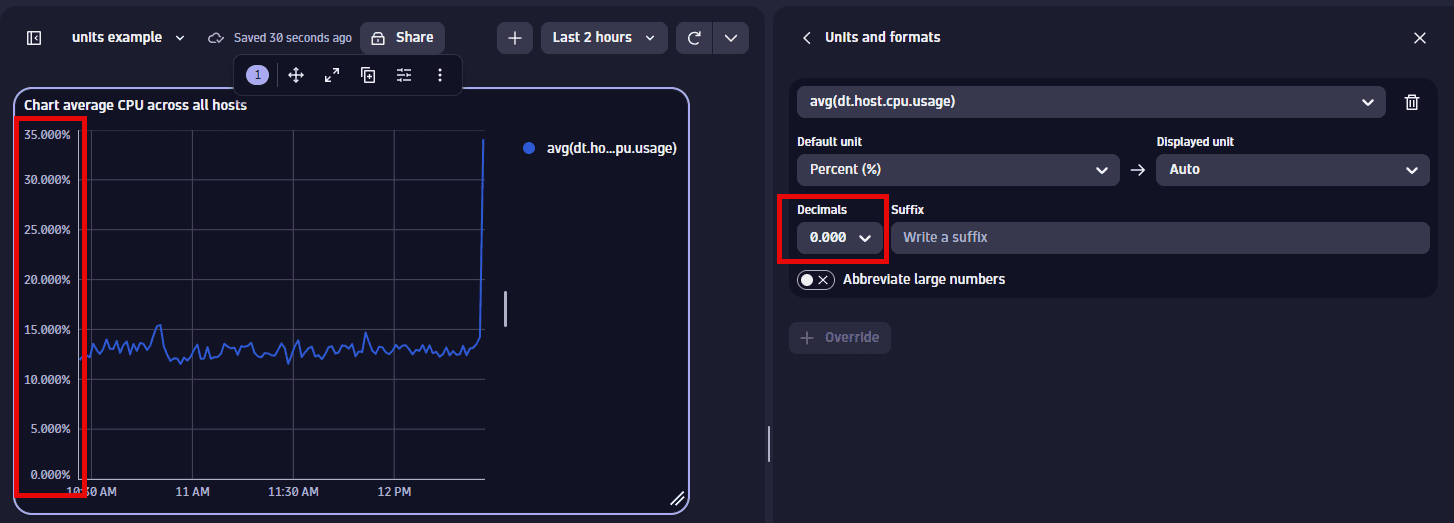
To this:
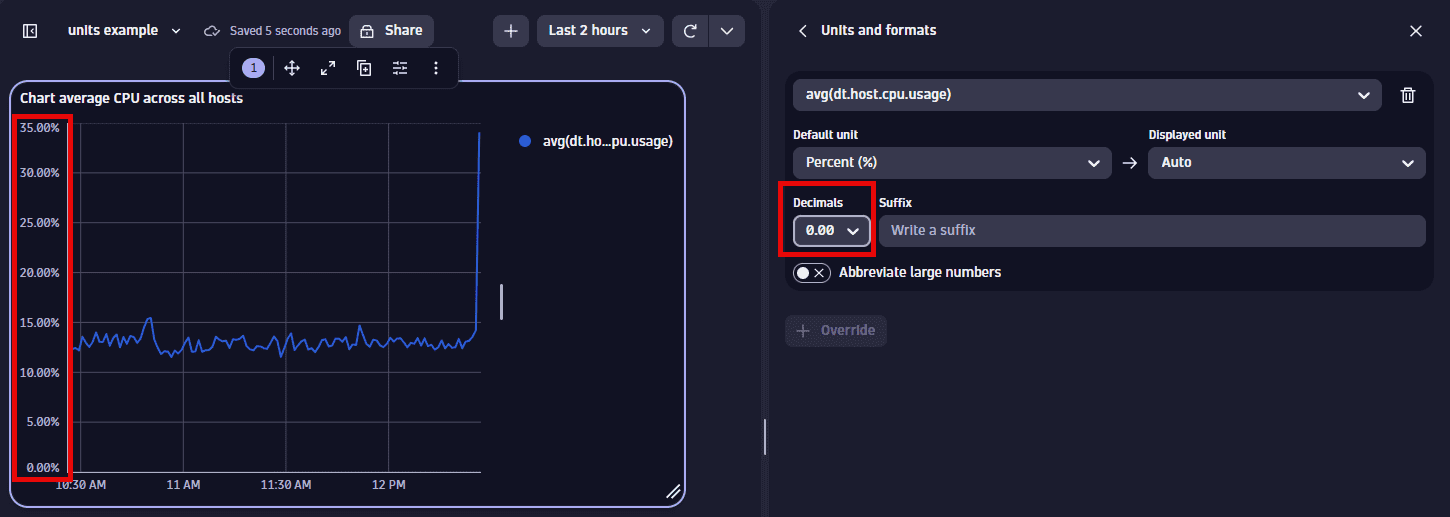
-
Suffix displays the optional suffix to display after the unit. To see it in action, enter a string and observe the change in the visualization.
-
To reset to defaults (discard override settings for the selected metric), select the trash can next to the metric.